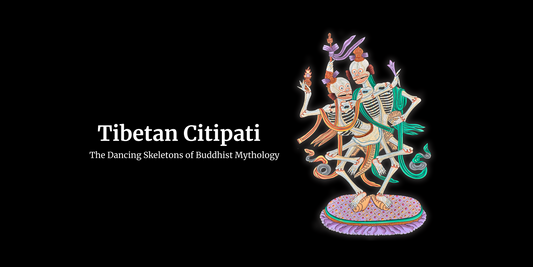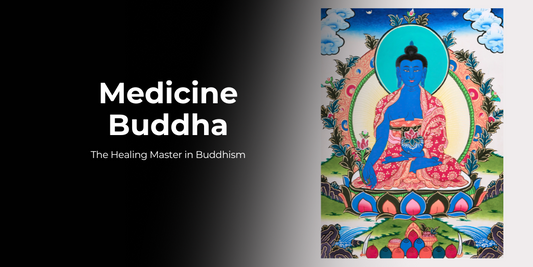- Buddhas Art of Healing
- Thangka
- Shakyamuni Buddha: Symbol of Peace, Enlightenment, Noble Teachings

Shakyamuni Buddha: Symbol of Peace, Enlightenment, Noble Teachings
Did you know that the Buddha commonly depicted in statues, thangkas, and temples around the world is specifically Shakyamuni Buddha?
Yes, the Shakyamuni Buddha. He is the symbol of enlightenment.
Let’s explore the true story of Shakyamuni Buddha, the founder of Buddhism, and understand his noble teachings.
Who is Shakyamuni Buddha?
Shakyamuni Buddha, also known as Buddha Gautama, Shakyamuni, or Siddhartha Gautama, is the historical Buddhist figure who introduced the world to the path of enlightenment.
Even after 2500 years, his presence is still deeply felt. His timeless teachings have transformed countless lives, inspiring spiritual believers and followers globally.
Understanding Shakyamuni Buddha deeply brings clarity and peace. Siddhartha Buddha was born in the 6th century BCE as the prince of a royal family.
Despite living a luxurious life, he always felt an inner emptiness. Driven by a longing for truth behind his hollow feeling, he renounced his royal privileges at the age of 29.
After nearly six years of intense meditation under the Bodhi tree in Bodhgaya, he attained enlightenment and became the Buddha Shakyamuni.
From that moment, Buddha Siddhartha Gautam Shakyamuni taught the path of inner peace, mindfulness, and liberation.

Invite peace and wisdom into your surroundings with our hand-painted Shakyamuni Buddha Thangkas. Explore the full collection.
Key Events in Shakyamuni Buddha’s Life
|
Life Event |
Significance |
|
Birth in Lumbini |
Marks the beginning of the Buddha’s human journey |
|
The Four Encounters |
Siddhartha sees an old man, a sick person, a corpse, and a monk. These events lead him to realize the nature of suffering |
|
Renunciation |
Leaves his royal life at 29 age to seek spiritual liberation |
|
Enlightenment at Bodh Gaya |
Meditates under the Bodhi tree and attains enlightenment, becoming the Shakyamuni Buddha |
|
First teaching at Sarnath |
Delivers the first Sermon, teaching the Four Noble Truths and the Eightfold Path |
|
Parinirvana at Kushinagar |
Passes into parinirvana (final nirvana) at age 80, ending the cycle of rebirth |
Four Noble Truths: The Core of Buddha Shakyamuni’s Teachings
After attaining enlightenment, Shakyamuni Buddha gave his teachings. And these teachings became the core of all Buddhist teachings.
They are not strict rules or religious commands. Instead, they are simple truths about life. And anyone can understand through their own experience.
1. The truth of suffering (Dukkha)
This noble truth teaches us that life includes sufferings and dissatisfaction. We all experience birth, aging, illness, death, and emotional ups and downs. Even pleasant things are temporary. The main idea is that suffering is an unavoidable part of life because everything changes, and we often resist the change.
2. The truth of cause of suffering (Samudaya)
This noble truth teaches that the main cause of suffering is craving and attachment. Our desire for pleasure and fear of discomfort create a cycle of clinging, greed, and ignorance.
The root cause of suffering is our inner desire and misunderstanding of reality.
3. Truth of the Cessation of suffering (Nirodha)
The truth is, it is possible to end suffering. When we let our craving and attachment go, suffering stops. This peaceful state is called nirvana.
The main idea is that freedom from suffering is achievable through inner transformation.
4. The truth of path of the Cessation of suffering (Magga)
This noble truth gives us the practical method to reach freedom or the end of suffering. This involves ethical living, mental discipline, and wisdom. By following a clear, practical path, we can end suffering and reach enlightenment.
The Noble Eightfold Path: Middle Way
The Noble Eightfold Path is often called the Middle Way because it avoids the extremes of self-indulgence and severe self-denial. Shakyamuni Buddha discovered through his life that balance leads to liberation.
1. Right View (Samma Ditthi)
The Four Noble Truths, understanding life clearly. The teaching involves seeing the nature of reality, like impermanence, karma, and suffering. Everything through personal learning and insights rather than through blind belief.
2. Right Intention (Samma Sankappa)
Have pure and kind intentions. Let your action come from compassion and goodwill. The teaching encourages us to act with compassion. Let go of the selfish desires, and avoid harmful thoughts like hatred or cruelty.
3. Right Speech (Samma Vaca)
Speak truthfully, kindly, and helpfully. Avoid lying, gossiping, or using harsh and divisive words. Use speech to create harmony and understanding.
4. Right Action (Samma Kammanta)
Live ethically. Don't harm others, don't steal, and avoid sexual misconduct. These actions create good karma and support inner peace. Act with morality and do no harm.
5. Right Livelihood (Samma Ajiva)
Earn a living without hurting others. Avoid works that involve violence, cheating, or exploitation. Support yourself through honest, non-harmful work.
6. Right Effort (Samma Vayama)
Make a consistent effort to let go of harmful thoughts and actions while developing positive, wholesome ones. Be mindful of your mental habits and work to improve them.
7. Right Mindfulness (Samma Sati)
Stay fully present and aware of your body, feelings, and thoughts without judgment. This awareness helps us see things as they really are. Be fully aware of the present moment.
8. Right Concentration (Samma Samadhi)
Practice deep meditation to focus the mind. This leads to calm, clarity, and insight into the true nature of existence. Develop inner stillness through focused meditation.

Explore this sacred thangka depicting Shakyamuni Buddha in serene meditation, surrounded by nature and inviting reflection on enlightenment.
The Four Noble Truths and the Noble Eightfold Path are not ancient theories—they are tools for modern life. They teach us how to live with compassion, wisdom, and balance, regardless of religion or culture.
Following this path helps reduce suffering, improve mental well-being, and create harmony in personal and community life.
Symbolism of Buddha Shakyamuni in Art, Thangkas & Statues
When you see a Shakyamuni Buddha statue or a thangka art painting, every detail has meaning. These details reflect his teachings, inner peace, and wisdom.
Let’s understand symbolic elements through Shakyamuni Buddha’s thangka painting:
|
Symbol/Feature |
Meaning |
|
Seated Position (Dhyana Mudra) |
Represents meditation and stability |
|
Right Hand Touching Earth (Bhumisparsha Mudra) |
Symbolizes moment of enlightenment |
|
Golden Body Color |
Signifies purity, divinity, and enlightenment |
|
Lotus Throne |
Foundation of purity |
|
Green Halo Around Head |
Aura of awakened wisdom |
|
Left Hand Holding Bowl |
Signifies detachment and the simplicity of monastic life |

Each Shakyamuni Thangka in our collection is painted with devotion and blessed by tradition. Explore our Shakyamuni Buddha Thangkas collection now.
Benefits of Having a Shakyamuni Buddha Thangka
Owning a Shakyamuni Buddha Thangka isn’t just about decoration—it's about bringing sacred energy into your life.
|
Benefit |
Description |
|
Enlightenment |
A spiritual guide in visual form, constant reminder of spiritual awakening, mindfulness, and compassion |
|
Spiritual Protection |
Cleanse energy in your home, focal point for concentration and reflection |
|
Peace in Chaotic world |
Detox digital noise and anxiety and brings deep sense of peace and grounding |
|
Cultural appreciation |
Honors ancient wisdom, cultural heritage, spiritual lineage; supports living tradition |
|
Aesthetic and energetic value |
Complements serene, mindful interior designs and eliminates negativity, inviting harmony |
Why Choose Our Shakyamuni Buddha Artworks?
At Buddha’s Art of Healing, we offer ethically sourced, hand-painted Thangkas and crafted Shakyamuni Buddha thangkas that honor the spiritual and artistic legacy of the Buddha.
What Makes Our Collection Unique:
- Hand-painted by Himalayan artisans
- Made with natural mineral pigments and cotton canvas
- Available in master-level and intermediate-level craftsmanship
- Infused with spiritual intent and blessed before shipping
|
Artist Level |
Description |
|
Intermediate |
Simple yet detailed, perfect for personal meditation |
|
Master |
Highly intricate, museum quality—ideal for collectors and temples |

Shop Shakyamuni Buddha Thangkas from Buddha's Art of Healing.

1. Is Shakyamuni similar to Gautama Buddha?
Yes. Shakyamuni is similar to Gautam Buddha. He is also known by other names like Buddha Gautama Shakyamuni and Buddha Siddhartha Gautama Shakyamuni.
2. What is the difference between the Shakyamuni thangka and other Buddha thangkas?
Other Buddha idols represent the celestial Buddhas or symbolic aspects. Whereas, the Shakyamuni thangkas represent the enlightenment of the Gautam Buddha.
3. Can non-Buddhists use Shakyamuni Buddha art?
Yes, non-Buddhists can also use Buddha art. Shakyamuni Buddha shows the symbol of self-knowledge, peace, mindfulness, and spiritual development.
Conclusion: Embrace the Path of Peace
The teachings of Shakyamuni Buddha have been relevant since its awakening period. This reminds us that awakening starts within. Inner peace is possible regardless of the external circumstances.
Explore our exclusive hand-painted Shakyamuni Buddha Thangkas, including many other deity thangkas, to bring his enlightened energy into your life today.
Visit Buddha’s Art of Healing and explore our Shakyamuni Buddha Thangka collections.
Connect with us on Instagram and Facebook for more updates.



